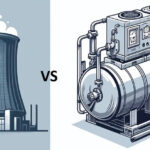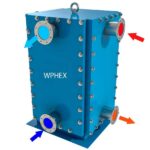Weymouth equation is used for gas pipeline systems, when large pipe diameters are involved the Weymouth equation can be used to calculate the flow rate. The equation is also employed for compressible gases and high pressure gases.
Below are two different forms that the Weymouth equation can be written in.
Weymouth equation in English/US units
The equation below is written for calculating the flow rate
\[Q\ =\ 433.5\cdot\left(\frac{T_b}{P_b}\right)\cdot\left(\frac{P_1^2-e^sP_2^2}{G\cdot T_f\cdot L_e\cdot Z}\right)^{0.5}\cdot D^{2.667}\cdot E\]
\[L_e=\frac{L\cdot\left(e^s-1\right)}{s}\]
Elevation difference:
\[s\ =\ 0.0375\cdot G\cdot\left(\frac{H_2-H_1}{T_f\cdot Z}\right)\]
Where; Q = Volume flow rate, SCFD (standard ft3/d) E = Pipeline efficiency, a value less than 1 Tb = base temperature, 'R (460 + 'F) Pb = base pressure, psia P1 = upstream pressure, psia P2 = downstream pressure. psia G = gas gravity (air = 1) Tf = Gas flow temperature at average condition, 'R Le = equivalent length of pipe segment, miles L = length of pipe segment, miles Z = gas compressibility factor, dimensionless D = pipe inside diameter, in s = elevation adjustement parameter, dimensionless H1 = upstream elevation, ft H2 = downstream elevation, ft
Weymouth equation in SI units
The equation below is written for calculating the flow rate
\[Q\ =\ 3.7435\cdot10^{-3}\cdot\left(\frac{T_b}{P_b}\right)\cdot\left(\frac{P_1^2-e^sP_2^2}{G\cdot T_f\cdot L_e\cdot Z}\right)^{0.5}\cdot D^{2.667}\cdot E\]
\[L_e=\frac{L\cdot\left(e^s-1\right)}{s}\]
Elevation difference:
\[s\ =\ 0.0684\cdot G\cdot\left(\frac{H_2-H_1}{T_f\cdot Z}\right)\]
Where; Q = Volume flow rate, standard m3/d E = Pipeline efficiency, a value less than 1 Tb = base temperature, 'K (273 + 'C) Pb = base pressure, kPa P1 = upstream pressure, kPa P2 = downstream pressure. kPa G = gas gravity (air = 1) Tf = Gas flow temperature at average condition, 'K Le = equivalent length of pipe segment, km L = length of pipe segment, km Z = gas compressibility factor, dimensionless D = pipe inside diameter, mm s = elevation adjustement parameter, dimensionless H1 = upstream elevation, m H2 = downstream elevation, m
The Pipeline efficiency value “E” is generally around 0.92, head gas would have a pipeline efficiency of 0.77, while gas and condensate pipes have an efficiency of 0.66
Other forms for Weymouth equation
The weymouth equation has also been written in different forms,
Thomas R. Weymouth presented this formula in 1912 for calculating gas flow through high-pressure pipelines. This formula is also used with the flow of compressed air.
\[Q\ =\ 21.8742\ \cdot\ \frac{T_s}{P_s}\cdot\sqrt{\frac{\left(P_1^2-P_2^2\right)\cdot D^{5.3333}}{T\cdot L}}\]
Where; Q = volume flow rate, SCFD (standard ft3/d) Ps = pressure at standard conditions, psia Ts = temperature at standard conditions, psia P1 = upstream pressure, psia P2 = downstream pressure, psia T = air flow teamperature, 'R D = pipe inside diameter, in L = pipe length, ft
Refrences
- E. Shashi Menon, Transmission pipeline calculations and simulations manual, Elsevier inc., 2015
- E. Shashi Menon, Piping calculations manual, McGraw-Hill, 2005











